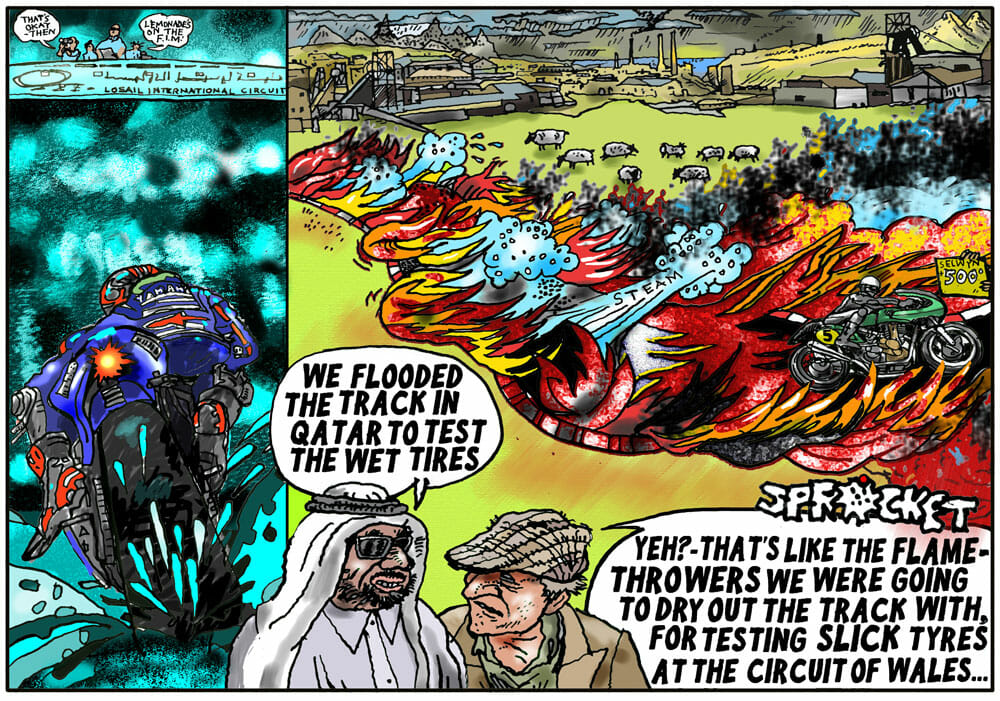Michael Scott | March 13, 2018
In The Paddock | Climate Change – Why Wait for Nature?
COLUMN
They call it climate change. It’s caused, there seems no doubt, by emissions. Very much including those from there being too many vehicles on the road.
That was certainly the case at Qatar, where, as always, if nature doesn’t oblige, then spending a bunch of oil money can make up the deficit. Usually, anyway.
Too many vehicles in this case comprised more than 60 tanker trucks, containing that commodity even more precious in the bleak and cheerless desert than petrol. Water. And they were emitting it in great gushing gouts onto the Losail circuit.
This was to investigate a problem that was itself already entirely man-made: to see if it would be possible to race under floodlights if it was raining. This was previously ruled impossible. Not because there was anything intrinsically wrong with the surface, but the dazzle in the spray and the reflections off the wet track would, it was assumed, be effectively blinding.
This, however, had become increasingly inconvenient, and it was time to think again.

Click here to read this in the Cycle News Digital Edition Magazine.
Dorna men and previous champions Franco Uncini and Loris Capirossi last year essayed a rather abortive trial, the former in a rentacar, the latter on a road bike.
Now a more serious trial was put into motion, with all the MotoGP riders invited to go out for half an hour, preferably in groups, to see how things were.
The answer, by the way, was mixed, though as usual wisecracking Danilo Petrucci got the best line, when he said that the visibility was atrocious, “but when you’re racing in the rain, that’s normal”.
But it was another great example of the sheer hubris underlying the opening round of the modern MotoGP season—a position on the calendar for which the Qatari’s are happy to pay handsomely, a wad of cash that Dorna is naturally happy to accept. At least in this case, unlike that of the football world cup that kicks off in Qatar in mid-June, we can assume that at least some of that money goes towards supporting less wealthy venues. Like the USA.
I recall the proud boast when nighttime racing was introduced at Losail in 2008: that the floodlighting was sufficient to provide street lighting all the way from the nearby capital city Doha to Moscow. Now there is a journey you don’t want to make. In either direction.
In truth, the floodlighting is pure vanity, transformed by circumstances into a monumental folly. Racing after dark might have made sense in the first two years of the race, 2004 and 2005, when the Qatar race was held in blazing hot October. But by the time the lights were installed, it had already become the first race of the season, held in March. And the trouble is, during the parched country’s laughable excuse for springtime, that it does actually rain, sometimes very generously.
At the same time, temperatures during the day are not so insupportably hot as to require nighttime running. There’s no need to race after dark. A fact reflected in the change to this year’s scheduling, when racing will start in daylight at 4 p.m., and finish by 8 p.m. Everything runs two hours earlier, and the whole meeting is one day shorter. A welcome move back towards common sense, and not before time.
Who can forget 2009, when a biblical downpour coincided exactly with the start of the MotoGP race, which had to be postponed by 24 hours? Or last year, when flooding rains cancelled qualifying, and the race was delayed by 40 minutes?
Dorna’s bulging pockets notwithstanding, this gives their functionaries a big headache. And the thrust of the post-test flooding was to establish whether it would be possible, should rain strike again, to go ahead anyway, without having to disrupt the sacred TV slots.
The results. As we have seen, were a little inconclusive. But that is in general the nature of testing. It was the same when it wasn’t raining over the previous three days, as the pre-season testing period ended. The time sheets were not conclusive. Merely suggestive.
They did prove some things that we already knew.
That top time setter Johann Zarco is well able to embarrass the factory Yamahas, despite (or perhaps because of) his two-year-old motorcycle. That Rossi is always capable of springing a surprise. That Marquez is overall favorite, because this time Honda haven’t given him any built-in drawbacks. That Dovi and the Ducati are an even greater threat than last year. And that the rubber roulette of the multi-choice Michelins will help to make things unpredictable.
And rain in the desert?
The easiest way of dealing with the threat would be to roof in the entire 3.4 miles. But please don’t tell the Qatari promoters, because they’ll probably go ahead and do it. CN